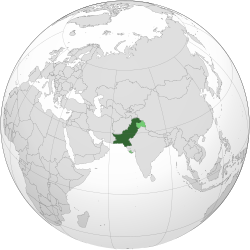Islamic Republic of Pakistan | |
|---|---|
Motto:
| |
Anthem:
| |
 Land controlled by Pakistan shown in dark green; land claimed but not controlled shown in light green (see Kashmir conflict and Annexation of Junagadh) | |
| Capital | Islamabad 33°41′30″N 73°3′0″E / 33.69167°N 73.05000°E |
| Largest city | Karachi 24°51′36″N 67°0′36″E / 24.86000°N 67.01000°E |
| Official languages | |
| Native languages | Over 77 languages[4] |
| Religion |
|
| Demonym(s) | Pakistani |
| Government | Federal parliamentary Islamic republic |
| Asif Ali Zardari | |
| Shehbaz Sharif | |
| Yusuf Raza Gilani | |
| Ayaz Sadiq | |
| Yahya Afridi | |
| Legislature | Parliament |
| Senate | |
| National Assembly | |
| Independence from the United Kingdom | |
| 23 March 1940 | |
| 14 August 1947 | |
• Republic | 23 March 1956 |
| 8 December 1958 | |
| 16 December 1971 | |
| 14 August 1973 | |
| Area | |
• Total | 881,913 km2 (340,509 sq mi)[b][6] (33rd) |
• Water (%) | 2.86 |
| Population | |
• 2023 census | |
• Density | 273.8/km2 (709.1/sq mi) (56th) |
| GDP (PPP) | 2024 estimate |
• Total | |
• Per capita | |
| GDP (nominal) | 2024 estimate |
• Total | |
• Per capita | |
| Gini (2018) | low inequality |
| HDI (2022) | low (164th) |
| Currency | Pakistani rupee (₨) (PKR) |
| Time zone | UTC+05:00 (PKT) |
| DST is not observed. | |
| Date format |
|
| Drives on | left[9] |
| Calling code | +92 |
| ISO 3166 code | PK |
| Internet TLD | |
Pakistan,[e] officially the Islamic Republic of Pakistan,[f] is a country in South Asia. It is the fifth-most populous country, with a population of over 241.5 million,[g] having the second-largest Muslim population as of 2023. Islamabad is the nation's capital, while Karachi is its largest city and financial centre. Pakistan is the 33rd-largest country by area. Bounded by the Arabian Sea on the south, the Gulf of Oman on the southwest, and the Sir Creek on the southeast, it shares land borders with India to the east; Afghanistan to the west; Iran to the southwest; and China to the northeast. It shares a maritime border with Oman in the Gulf of Oman, and is separated from Tajikistan in the northwest by Afghanistan's narrow Wakhan Corridor.
Pakistan is the site of several ancient cultures, including the 8,500-year-old Neolithic site of Mehrgarh in Balochistan, the Indus Valley Civilisation of the Bronze Age,[10] and the ancient Gandhara civilisation.[11] The regions that compose the modern state of Pakistan were the realm of multiple empires and dynasties, including the Gandhāra, the Achaemenid, the Maurya, the Kushan, the Parthian, the Paratarajas, the Gupta;[12] the Umayyad Caliphate in its southern regions, the Hindu Shahis, the Ghaznavids, the Delhi Sultanate, the Samma, the Shah Miris, the Mughals,[13] the Durranis, the Sikhs and most recently, the British Raj from 1858 to 1947.
Spurred by the Pakistan Movement, which sought a homeland for the Muslims of British India, and election victories in 1946 by the All-India Muslim League, Pakistan gained independence in 1947 after the Partition of the British Indian Empire, which awarded separate statehood to its Muslim-majority regions and was accompanied by an unparalleled mass migration and loss of life.[14][15] Initially a Dominion of the British Commonwealth, Pakistan officially drafted its constitution in 1956, and emerged as a declared Islamic republic. In 1971, the exclave of East Pakistan seceded as the new country of Bangladesh after a nine-month-long civil war. In the following four decades, Pakistan has been ruled by governments whose descriptions, although complex, commonly alternated between civilian and military, democratic and authoritarian, relatively secular and Islamist.[16]
Pakistan is considered a middle power nation,[17][h] with the world's sixth-largest standing armed forces. It is a declared nuclear-weapons state, and is ranked amongst the emerging and growth-leading economies,[18] with a large and rapidly-growing middle class.[19][20] Pakistan's political history since independence has been characterized by periods of significant economic and military growth as well as those of political and economic instability. It is an ethnically and linguistically diverse country, with similarly diverse geography and wildlife. The country continues to face challenges, including poverty, illiteracy, corruption, and terrorism.[21][22][23] Pakistan is a member of the United Nations, the Shanghai Cooperation Organisation, the Organisation of Islamic Cooperation, the Commonwealth of Nations, the South Asian Association for Regional Cooperation, and the Islamic Military Counter-Terrorism Coalition, and is designated as a major non-NATO ally by the United States.
- ^ Minahan 2009.
- ^ Jaffrelot 2015, p. 97.
- ^ Ayres 2009.
- ^ Eberhard, Simons & Fennig 2022.
- ^ James 2022.
- ^ Bhandari 2022.
- ^ a b c d IMF 2024.
- ^ a b IMF 2023.
- ^ Haleem 2013.
- ^ Cite error: The named reference
Wright-2009was invoked but never defined (see the help page). - ^ Badian 1987.
- ^ Wynbrandt 2009.
- ^ Spuler 1969.
- ^ Cite error: The named reference
Copland-2001was invoked but never defined (see the help page). - ^ Cite error: The named reference
Metcalf-2006was invoked but never defined (see the help page). - ^ Talbot 2016.
- ^ Cite error: The named reference
Middle power nationwas invoked but never defined (see the help page). - ^ Zia & Burton 2023.
- ^ Rais 2017.
- ^ Cornwall & Edwards 2014.
- ^ Joseph 2016.
- ^ Baqir 2018.
- ^ SATP 2024.
Cite error: There are <ref group=lower-alpha> tags or {{efn}} templates on this page, but the references will not show without a {{reflist|group=lower-alpha}} template or {{notelist}} template (see the help page).

